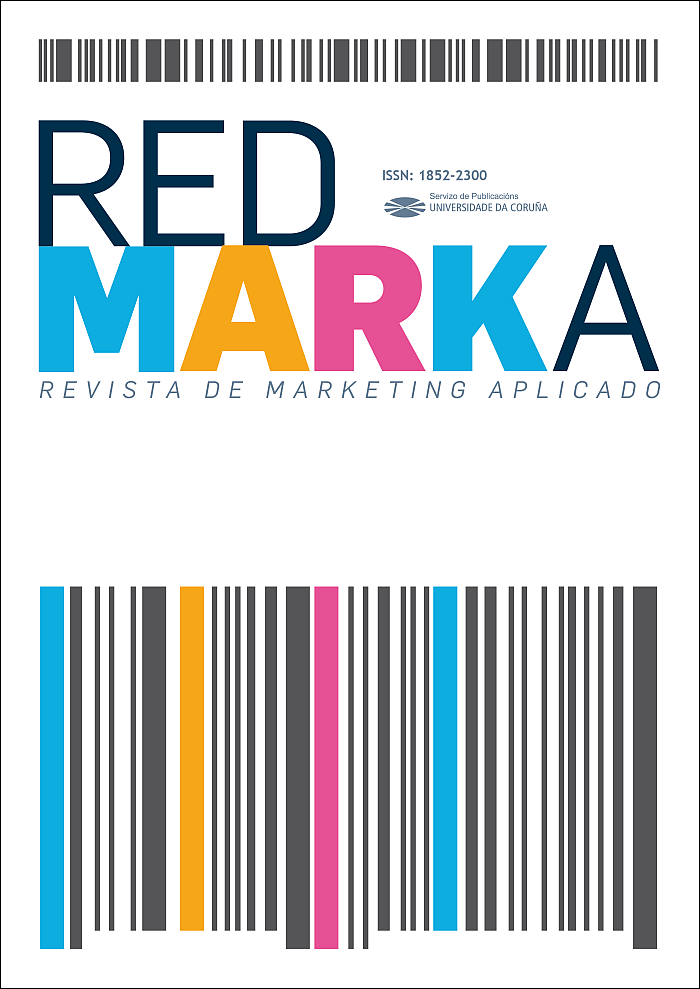Assessing brand experience in Instagram advertising
Main Article Content
Abstract
People’s experience of advertising on social media plays an important role in digital marketing management. The concept of ‘brand experience’ is one way for managers to improve their understanding of how to optimise customer attention and connection with brands. The aim of this study is to identify the main components of the experience of clothing advertising on the social network Instagram. The study consisted of a quantitative analysis based on data collected through an online survey. The results of the descriptive and factor analysis revealed three main factors: behavioural, affective and intellectual. The article concludes with a discussion of all three.
Keywords:
Downloads
Article Details
References
Alba, J. W., y Hutchinson, J. W. (1987). Dimensions of consumer expertise. Journal of consumer research, 13(4), 411-454. https://doi.org/10.1086/209080
Beig, F. A., y Khan, M. F. (2018). Impact of social media marketing on Brand Experience: A study of select apparel brands on Facebook. Vision, 22(3), 264-275. https://doi.org/10.1177/0972262918785962
Bigné, E., Küster, I., y Hernández, A. (2013). Las redes sociales virtuales y las marcas: influencia del intercambio de experiencias eC2C sobre la actitud de los usuarios hacia la marca. Revista española de Investigación de Marketing ESIC, 17(2), 7-27. https://doi.org/10.1016/S1138-1442(14)60022-X
Brakus, J. J., Schmitt, B. H., y Zarantonello, L. (2009). Brand Experience: what is it? How is it measured? Does it affect loyalty? Journal of marketing, 73(3), 52-68. https://doi.org/10.1509/jmkg.73.3.052
Braunsberger, K. y Munch, J.M. (1998). Source expertise versus experience effects in hospital advertising. Journal of Services Marketing, 12(1), pp. 23-38. https://doi.org/10.1108/08876049810202348
Cachia, R. (2008). Los sitios de creación de redes. Aspectos sociales. Telos, 76(1), 69-84.
Curras, R., Ruiz, C., y Sanz, S. (2011). Antecedentes y consecuencias de la actitud hacia el uso de las redes sociales. En XXIII Congreso Nacional de Marketing. Castellón: AEMARK.
Ferreira, P., y Rodrigues, P. (2019). Brand love as mediator of the Brand Experience-satisfaction-loyalty relationship in a retail fashion brand. Management y Marketing, 14(3), 278-291. https://doi.org/10.2478/mmcks-2019-0020
González Alonso, J., y Pazmiño Santacruz, M. (2015). Cálculo e interpretación del Alfa de Cronbach para el caso de validación de la consistencia interna de un cuestionario, con dos posibles escalas tipo Likert. Revista publicando, 2(1), 62-67.
Ha, H. Y., y Perks, H. (2005). Effects of consumer perceptions of brand experience on the web: Brand familiarity, satisfaction and brand trust. Journal of Consumer Behaviour: An International Research Review, 4(6), 438-452. https://doi.org/10.1002/cb.29
Iglesias, O., Singh, J. J., y Batista-Foguet, J. M. (2011). The role of Brand Experience and affective commitment in determining brand loyalty. Journal of Brand Management, 18(8), 570-582. https://doi.org/10.1057/bm.2010.58
Jany Castro, J. N. (2001). Investigación integral de mercados: Un enfoque para el siglo XXI. McGraw-Hill.
Knights, M. I. Y. A. (2007). Web 2.0 [web technologies]. Communications Engineer, 5(1), 30-35.
Kuo, D. y Yen, S. (2009). Towards an understanding of the behavioral intention to use 3G mobile value-added services. Computers in Human Behavior, 25(2), 103-110. https://doi.org/10.1016/j.chb.2008.07.007
Lee, J.; Park, D.-H. y Han, I. (2008). The effect of negative online consumer reviews on product attitude: An information processing view. Electronic Commerce Research and Applications, 7(3), 341-352. https://doi.org/10.1016/j.elerap.2007.05.004
López-Roldán, P., y Fachelli, S. (2015). Metodología de la investigación social cuantitativa. Universitat Autònoma de Barcelona.
Losada O. M., y Sánchez, I. D. (2018). The role of social media in the creation of Brand Experiences. Cuadernos de Administración, 34(61), 86-96.
Mendivelso, F., y Rodríguez, M. (2018). Prueba Chi-Cuadrado de independencia aplicada a tablas 2xN. Revista Médica Sanitas, 21(2), 92-95.
Oliver, R. L. (2006). Customer satisfaction research. The handbook of marketing research: Uses, misuses, and future advances. SAGE Publications.
Ortegón, L., & Rodríguez, A. G. (2016). Gestión del marketing sensorial sobre la experiencia del consumidor. Revista de Ciencias Sociales, 22(3), 67-83.
Oviedo, H. C., y Arias, A. C. (2005). Aproximación al uso del coeficiente alfa de Cronbach. Revista colombiana de psiquiatría, 34(4), 572-580.
Padgett, D., y Allen, D. (1997). Communicating experiences: A narrative approach to creating service brand image. Journal of advertising, 26(4), 49-62. https://doi.org/10.1080/00913367.1997.10673535
Revista P&M. (2020). Colombia, líder en Latinoamérica en publicidad digital. https://revistapym.com.co/mercadeo/colombia-lider-en-latinoamerica-en-publicidad-digital
Suárez, O. M. (2007). Aplicación del análisis factorial a la investigación de mercados. Caso de estudio. Scientia et technica, 1(35).
Wang, S.; Moon, S.; Kwon, K.; Evans, C. y Stefanone, M. (2010).Face off: Implications of visual cues on initiating friendship of Facebook. Computers in Human Behavior, 26(2), 226-234. https://doi.org/10.1016/j.chb.2009.10.001
Yu, X., Yuan, C., Kim, J., & Wang, S. (2021). A new form of brand experience in online social networks: An empirical analysis. Journal of Business Research, 130, 426-435. https://doi.org/10.1016/j.jbusres.2020.02.011







